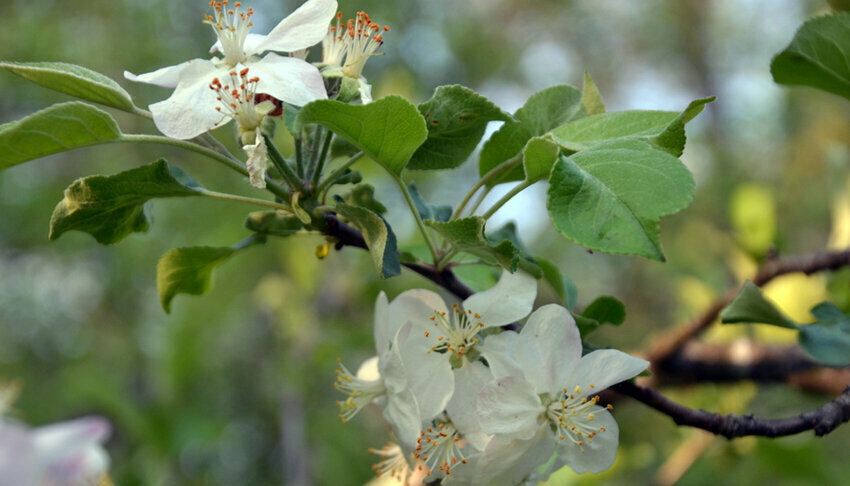
James Card Photo
By James Card
Waupaca County’s apple tree historian is close to a second big discovery.
In 2016, Henry Jacobson discovered a Ratzburg, an apple tree near Fremont that was over 170 years old and 40 feet tall.
On the website, Pomiferous, the world’s most extensive apple database, the Ratzburg is described as “an obscure apple that was believed to have disappeared.”
Finding a Ratzburg in Waupaca County was a big deal in the world of apple growers and Jacobson helped distribute it to other apple growers through the North American Fruit Explorers, a group he belongs to.
Now Jacobson is on the cusp of finding another lost-to-history heirloom apple tree.
“I may have re-discovered another Waupaca County variety. I’m sending DNA of leaf samples out to Washington in the next couple weeks to double check. You never really know with old trees but a lot of times all these characteristics match up and the DNA test comes back as no positive matches with any of the thousands of apples in the database, so then there is a re-discovery right there,” said Jacobsen who is holding back the name of the variety until he is 100 percent sure.
The skin characteristics match a description of the apple from a catalogue from the 1900s. It also matches up with descriptions from the proceedings of horticultural clubs in Waupaca County. The sweet flavor matches and it also keeps for a long-time, another unique feature of the apple.
“I grafted about ten trees from it this spring. This apple tree wasn’t planted on the original farm of where it originated but it’s only a half a mile down the road from where it was originally planted. So you take all those key favors and put them together and make a good case for re-discovery. That’s what I did with the Ratzburg. Everything matched with the description, the size, the location, the flavor," Jacobsen said.
He has a list of 89 Waupaca County varieties that are named that he compiled from multiple sources, including old nursery catalogues from a collection at UW-Stevens Point.
Jacobson cited some stories of apple hunters out west who believed they discovered a new variety of apple tree but after DNA testing, it matched up with an obscure apple tree that was cultivated in the eastern U.S.
“They really thought these were long-lost apples but that’s just the name of the game with some of the stuff that doesn’t have records,” he said.
Over the past four years he’s accompanied a professor from UW-Oshkosh to the Keweenaw Peninsula in Michigan’s Upper Peninsula to explore ghost towns where miners planted apple trees as they lived and worked at now-abandoned mines. Some places still have a few old buildings left and they get permission to explore the properties.
“We go up there in the fall and we tag apples that we through would be worthy of trial in an orchard—or good for cider. I graft them,” said Jacobson.
Jacobson is a bicyclist and he uses it as a vehicle for seeking new apples. “Of course, with the apple hunter in me, I’ll see an apple by the side of the road, I’ll stop and quick look for cars and run into the ditch and grab apple, see if it’s good or not and mark it on the map,” he said.
Not all finds are a rare variety and not are all great apples. He must determine if the tree was grafted or a wild seedling. If it was grafted, then it was from a variety that a person deemed valuable enough to propagate. If it is a wild seedling, then it is a long-odds genetic crapshoot that the apple will be tasty enough for eating, cider making or even baking.
Jacobson looks for a graft union that looks like a bump on its trunk. “You get to know the varieties they planted in back in the day. If this apple is the same as the last apple, and they are both 100-year-old trees, then they are both definitely grafted. But a seedling on the roadside, like a ten-year-old apple tree with 20 apples on it in a ditch, somebody threw it [an apple core] out the car window and it grew up and then that’s its own unique variety,” he said.
Jacobson is a Hortonville High School graduate and now lives in Appleton and works at Pierce Manufacturing. He earned a horticultural degree from Fox Valley Technical Collage and in 2020, he bought 18 acres of land south of Iola. His plan was to build a house there, start a family and grow apple trees. He planted 270 apple trees and 85 were heirloom varieties.
He didn’t like the idea of commuting two hours to work every day so he sold the land. “It was sad to see it go but I feel good about the decision,” he said.
He left behind some of the trees that were too big to transplant and moved the others to nursery beds at his parent’s place in New London. Now he is looking for a small acreage to plant the trees but he said the real estate market was tough. He was recently out-bid on a property from a buyer that came out of nowhere.
“I just want to have an orchard and grow really old apple trees, try some new ones out and spread the word about heirloom apples because honestly—they are so good,” said Jacobson.